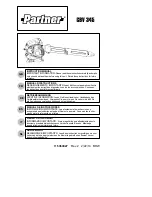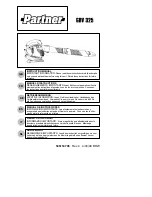
Steering System 359
Service Manual – CS7000
As the steering wheel rotates, the A1 signal switches back and forth from 0v (low) to 5v (high). When viewed
on a scope (oscilloscope) it looks like a “square wave” pattern. When the steering wheel rotation is slow, the
switching frequency is slow. This is seen as longer and fewer square wave patterns on the scope screen.
When the steering wheel rotation is faster, the switching frequency is faster. This is seen as more but
shorter patterns on the scope screen. This changing frequency is how the controller “sees” the steering wheel
rotation speed. The same is true for all 4 signals.
WaveStar : NotesSheet(2) Page: 1
Fast Rotation
WaveStar : NotesSheet(1) Page: 1
Slow Rotation
In order to determine which direction the steering wheel is rotating, the controller “looks” at two signals ( A1
and B1) at a time. These signals are intentionally offset (out of phase) from one another. This is “physically”
built into the way the encoder works. When A1 and B1 are both reporting “low”, the controller will be able to
tell which direction the steering wheel is rotating by which of the signals goes “high” first. If A1 switches
high first, then the wheel turning left. If B1 switches first, the wheel is turning right. A2 and B2 are used as
an extra (redundant) pair of signals.
Right Turn
Left Turn
The steering wheel sensor also contains a TFD (Torque Feedback Device). The TFD is powered on the same
circuit as the controller J5-1. Power is supplied to a coil winding inside the TFD on sensor pin 10. The power
flows through the coil, out sensor pin 9 and into controller J5-2. Inside the controller, there is a “switch” that
opens and closes rapidly to provide a “controlled” ground for the coil. When a ground is supplied, current
flows through the winding and creates a magnetic field. As the percentage of ground time is increased, the
current flow increases causing a stronger magnetic field to be created in the TFD. The magnetic field creates
a “clamping” force on the TFD clutch pack, which in turn, provides “steering feel” to the operator.
There are two travel limit proximity switches. Each switch receives voltage on the same circuit as J5-1
(through the seat switch). The switches are normally open. When the cam “tooth” lines up with the switch,
the switch closes sending the voltage on to the steering controller. The right travel limit switch is connected
to J5-13. The left travel limit switch is connected to J5-19
Summary of Contents for CS7000 Fuel Cell EcoFlex
Page 147: ...Electrical System 147 Service Manual CS7000 56509170 Rev L Sheet 1 of 9 ...
Page 148: ...Electrical System 148 Service Manual CS7000 56509170 Rev L Sheet 2 of 9 ...
Page 149: ...Electrical System 149 Service Manual CS7000 56509170 Rev L Sheet 3 of 9 ...
Page 150: ...Electrical System 150 Service Manual CS7000 56509170 Rev L Sheet 4 of 9 ...
Page 151: ...Service Manual CS7000 151 Electrical System 56509170 Rev L Sheet 5 of 9 ...
Page 155: ...Electrical System 155 Service Manual CS7000 56509170 Rev L Sheet 9 of 9 ...
Page 357: ...Steering System 357 Service Manual CS7000 Steering System Wiring Diagram 36 V From Key Switch ...
















































